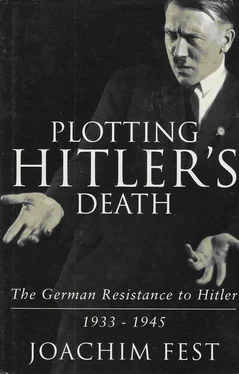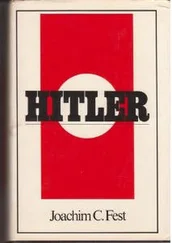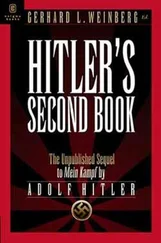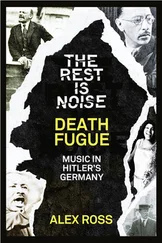Nothing illuminates Hitler’s continuing rancor toward the officer corps more than his appointment on July 20, 1944, of its most deadly rival, Heinrich Himmler, as the new commander of the reserve army, a well-calculated gesture of contempt. Himmler immediately set about reorganizing the German army into a National Socialist “people’s army.” He banned all references to the theory that the state rested on twin pillars, the Nazi Party and the army, a theory in which Blomberg and Reichenau had placed great stock. The German people did not consist of pillars, Himmler explained, and the army merely “carried out the functions of the party.” The army had been thoroughly degraded, yet more was to come. 16By the end of the war, the Waffen-SS had mushroomed to over seventeen divisions.
Another reason for the unwillingness of many officers to engage in any sort of resistance was their profound aversion to revolt against the state. That feeling was greatly reinforced by fear for the soldiers under them, who were already being badly beaten at the fronts and whose ability to defend themselves might well be further weakened by a coup. There is no question that many officers were tormented by the pressures placed on them and by concerns about justifying their actions. In this, they had much in common with the conspirators. As can be seen in the example of Tresckow, even officers who were absolutely determined to stage a coup were troubled by the fact that everything they were contemplating would inevitably be seen by their troops as dereliction of duty, as irresponsible arrogance, and, worst, as capable of triggering a civil war.
Scarcely less inhibiting, even to many of the conspirators themselves, was the idea of murdering the head of state. One could point, as Stauffenberg did, to the immense number of fatalities incurred every day in Hitler’s war and to his slaughter of entire populations. Psychologically, however, there is a great difference between the murder of one person and the killing of many, a difference difficult to comprehend and perhaps essentially symbolic in nature. 17Virtually none of the plotters was able to overcome these inhibitions, and in all likelihood not even Stauffenberg was prepared to dispatch Hitler “as if he were a mad dog,” as Gersdorff put it. The indecision over what to do with Hitler that marked the conspiracy of September 1938 and was even more acutely evident in November 1939 reflects the scruples the conspirators had to overcome.
The same problem plagued the planning for July 20, influencing events in almost imperceptible ways. The conspirators’ euphemistic reference to the murder of Hitler as the “initial spark” tended to minimize the importance of the act, making it seem a mere prelude when in fact it was the key event. Perhaps that is why the conspirators devoted much less time and attention to planning the action at the Wolf’s Lair than to the deception and surprise attacks of Operation Valkyrie. Not every detail of the assassination attempt could be foreseen, of course, but even so at noon on July 20, 1944 Stauffenberg found himself forced to make many more hasty last-minute decisions than were really necessary. The questions that continually puzzle observers-Why didn’t Haeften arm the bomb? Why wasn’t Stauffenberg adequately informed about the reduced power the bombs would have in a wooden hut? Why was the second bomb left unused and simply thrown out of the car on the way to the airfield?-are best answered with reference to the unconscious aversion to the murder of a head of state.
Many highly placed officers were also dissuaded from joining the opposition by their vivid memories of Hitler’s amazing string of triumphs both before the war and in its early years. They belonged to a generation that had known nothing but defeat and humiliation, from the First World War to Versailles to the never-ending insults of the Weimar Republic. They were therefore all the more impressed by Hitler’s victories, scored time and again in flagrant defiance of the warnings and advice of experts. Hitler’s uncanny success did much to undermine the officers’ confidence in their own judgment, especially as they had been trained and were accustomed, like military strategists in all other countries, to think strictly in terms of outcome.
A number of officers were also cool toward the resistance because, by the time war broke out, the notion of Hochverrat, or betrayal of the head of state, had become conflated with the odious crime of Landesverrat, betrayal of one’s country, for which there was absolutely no tolerance within the army. The complete isolation of Hans Oster, notwithstanding the personal respect accorded him, was a case in point. Even Stauffenberg remarked at the beginning of the Russian campaign that a putsch was unthinkable in time of war. 18Halder expressed similar sentiments, and it is no accident that he helped plan coups only before the war or, in the case of the 1939 plot, at a time when it seemed the conflict could still be prevented from escalating into a world war. 19
These were the dilemmas facing men like Rundstedt, Leeb, Sodenstern, and Kluge as they decided how they would respond to the impending assassination attempt and coup. They were by no means typical Nazi generals and they did not betray the conspirators, but neither did they provide encouragement or support. “Just do it!” is how General Heusinger responded on a number of occasions to requests from Tresckow’s circle to join the conspiracy. 20Like many others, Heusinger himself preferred to withdraw into a posture of more or less blind-or at least silent-obedience. A considerable number of these officers were capable of realizing that adherence to abstract ideals about a soldier’s duty would ultimately bring catastrophe on Germany and some, including Manstein and Bock, were expressly told as much by colleagues in the opposition. Most of them, however, continued to shrug their shoulders and seek solace in rationalizations, all the while nurturing the hope that disaster would ultimately be avoided, as it had been so many times in the past.
There were also those who, though they did not join the resistance, found the conflict of values unbearable and sought escape in death. This is the only way that Gerd von Tresckow’s insistence on incriminating himself can be understood. The commanding general at Cherbourg, Erich Marcks, was acting on a similar impulse when he headed into the front lines, telling those around him that a soldier’s death was the best a man could meet. Field Marshal Walter Model served the regime loyally for many years, but in mid-April 1945, while commanding his army group in the Ruhr valley, he was suddenly seized by the conviction that he had been serving a false master and a false cause; in despair, he committed suicide. His successor, Albert Kesselring, returned to business as usual; he inaugurated his command by complaining to his general staff that nowhere on his journey through the army area had he seen a hanged deserter, a sure sign of ineffective military leadership. 21
A final reason for the reluctance of most officers to assist the resistance was its lack of support among the general population, a state of affairs continually lamented by voices in the army ranging from Chief of General Staff Halder to General Wagner. The upper echelons of the military were staffed largely by men of high social rank who had little truck with the common people, and in the wake of the Reichenau and Fritsch affairs, nothing so impressed them as Hitler’s ability to sway the masses and make himself their wildly acclaimed spokesman. An attempt was made to use Wilhelm Leuschner’s network of former trade union members to bring the opposition message to the people, but this single initiative was not enough to break the social isolation of the rebels. Inquiries conducted primarily by Julius Leber and Alfred Delp in late 1943 indicated that most industrial workers remained loyal to the regime, even as the war ground on. Security Service reports on the mood of the people in the days following July 20 concluded that Hitler was increasingly popular even in such traditionally “red” areas as Berlin’s Wedding, a heavily working-class district. 22Although the resistance had for years been concerned with the problem of how to reach the general population and enlighten it as to the criminality of the Nazi regime, a satisfactory solution was never found.
Читать дальше




![Traudl Junge - Hitler's Last Secretary - A Firsthand Account of Life with Hitler [aka Until the Final Hour]](/books/416681/traudl-junge-hitler-s-last-secretary-a-firsthand-thumb.webp)







